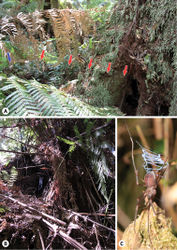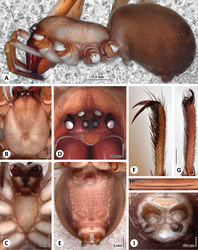Progradungula otwayensis
Contents
- 1 Taxonavigation
- 2 Name
- 3 Type material
- 4 Material examined
- 5 Diagnosis
- 6 Female
- 7 Measurements
- 8 Colour pattern
- 9 Eyes
- 10 Chelicerae
- 11 Maxillae
- 12 Labium
- 13 Sternum
- 14 Legs
- 15 Pattern of spination
- 16 Palp
- 17 Abdomen
- 18 Genitalia
- 19 Male
- 20 Male palp
- 21 Natural history
- 22 Distribution
- 23 Taxon Treatment
- 24 Images
- 25 Other References
| Notice: | This page is derived from the original publication listed below, whose author(s) should always be credited. Further contributors may edit and improve the content of this page and, consequently, need to be credited as well (see page history). Any assessment of factual correctness requires a careful review of the original article as well as of subsequent contributions.
If you are uncertain whether your planned contribution is correct or not, we suggest that you use the associated discussion page instead of editing the page directly. This page should be cited as follows (rationale):
Citation formats to copy and paste
BibTeX: @article{Michalik2013ZooKeys335, RIS/ Endnote: TY - JOUR Wikipedia/ Citizendium: <ref name="Michalik2013ZooKeys335">{{Citation See also the citation download page at the journal. |
Ordo: Araneae
Familia: Gradungulidae
Genus: Progradungula
Name
Progradungula otwayensis Milledge, 1997 – Wikispecies link – Pensoft Profile
Type material
Male holotype: AUSTRALIA: Victoria. Otway Ranges, Aire Crossing Track, 0.5 km N of Aire River crossing, 38°42’S, 143°29’E, 31 Jan 1995, G. Milledge (MV K3260, not examined).
Material examined
AUSTRALIA: VICTORIA: Great Otway National Park: Little Aire Cascade Trail, E of Lavers Hill, 38.67032°S, 143.49810°E (GPS, ±100m), elev. 330m, 11 Feb 2013, Nothofagus, Eucalyptus, tree ferns wet forest, hand collecting, P.Michalik & M.J.Ramírez (MJR-Loc-125), two females (MACN-Ar 30666); Triplet Falls Trail, E of Lavers Hill, 38.67188°S, 143.49673°E (GPS, ±300m), elev. 300m (GPS), 10 Feb 2013, Nothofagus, Eucalyptus, tree ferns wet forest, hand collecting, P.Michalik & M.J.Ramírez (MJR-Loc-124), three females (MACN-Ar 30667, ZIMG II/28128, ZIMG II/28129); Maits Rest Trail, W Apollo Bay, 38.75492°S, 143.55495°E (GPS, ±200m), elev. 240m, 13–14 Feb 2013, Nothofagus, tree ferns wet forest, hand collecting, P.Michalik & M.J.Ramírez (MJR-Loc-126), one female (ZIMG II/28130); Melba Gully Trail, 38°41.726’S, 143°22.312’E (GPS, ±200m), elev. 328m, 15 Feb 2013, Nothofagus, tree ferns wet forest, hand collecting, P.Michalik & M.J.Ramírez (MJR-Loc-128), one male (ZIMG II/28127).
Diagnosis
This species can be distinguished from Progradungula carraiensis by the single process on the embolus of the male palpal organ and the presence of eight spermathecae in the female genitalia.
Female
(Figs 3–4).
Measurements
(mm, in MV). Carapace length 6.92; carapace width 4.66; caput width 2.66; abdomen length 8.51; abdomen width 7.18. Legs: length of segments (femur + patella/tibia + metatarsus + tarsus = total length): I 11.97 + 14.10 + 11.57 + 2.66 = 40.30, II 9.31 + 10.77 + 8.25 + 2.53 = 30.86, III 7.98 + 9.18 + 7.85 + 2.13 = 27.14, IV 9.98 + 10.91 + 9.44 + 2.13 = 32.46, palp 2.93 + 2.66 + - + 2.79 = 8.38.
Colour pattern
Carapace yellowish brown, darker on cephalic area, particularly in eye region. Chelicerae, maxillae and labium reddish brown. Sternum reddish brown marginally, paler centrally. Legs yellowish brown. Abdomen fawn-coloured with dark brown dorsal pigmentation consisting of 3 chevron markings. Carapace longer than wide, widest between coxae II and III. Cephalic area elevated behind eyes (Fig. 3A). Clypeus sloping, as long as the median ocular quadrangle, with a strongly curved anterior border. Fovea pit-like.
Eyes
Frontal view (Fig. 3D): anterior row slightly recurved, posterior row slightly procurved. Dorsal view (Fig. 3B): anterior row recurved, posterior row slightly recurved. AME < PME < ALE = PLE 0.23: 0.32: 0.35: 0.35. Interdistances: AME-AME 0.18, AME-ALE 0.33, ALE-PLE 0.08, PLE-PME 0.40, PME-PME 0.28. Median ocular quadrangle: length 0.58 mm, anterior width 0.55 mm, posterior width 0.87 mm. Clypeus height 0.50. AME black, remainder white.
Chelicerae
Strong, vertical, slightly divergent. Three strong prolateral teeth, evenly spaced. Five very small retromarginal teeth (or denticles) in row on basal half of groove, with a spine on the apico-dorsal side. Stridulatory ridges absent.
Maxillae
Subparallel, external margin strongly curved and ending anteriorly in a bluntly pointed apex (Fig. 3C). Serrula present.
Labium
Free. Length 0.83, width 0.87. Apical margin indented, lateral margin subparallel below, sloping in toward apex above (Fig. 3C).
Sternum
Length 3.33, width 2.20. Elongate, shield-shaped with pointed apex which extends back midway between coxae IV (Fig. 3C).
Legs
1423. Trochanters shallowly notched. Superior claws of 1st and 2nd legs dissimilar, with raptorial proclaws long and strongly developed (Fig. 3F), retroclaws shorter. Inferior claws of legs I and II slender and strongly hooked. Superior claws of legs III and IV similar (Fig. 3G). Accessory claw setae on all tarsi. Distal half of tarsus I and II with strong ventral setae. Calamistrum short, located in second quarter of metatarsus 4 (Fig. 3H).
Pattern of spination
(Approximate, slightly asymmetrical.) Femur I d (r2p1)-r2-r1-p1-1-2-p1-2-p1-2-2-3ap v 0-p1-0-0-0; patella r 1; tibia d 2-0-2-p1-0-p1-3 v 2-0-0-2-p1-0-2-0; metatarsus d r1-p1-p1-0-0-0-0 v p1-r1-p1-p1-r1-p1-r1-2ap; II; femur d (r2p1)-r2-2-p1-2-p1-2- 2-p1-3 v 0-p1-1-0-0; patella p 1; tibia d 2-p1-1-2-2-p1-p1-1-3 v 2-0-p1-r1-p1-2-0-2ap; metatarsus d 2-p1-2-r1-p1-r1-p1-p1-2ap v p1-r1-2-2-r1-p1-3ap; III; femur d (r3p1)-1-r1-2-p1-2-2-2-r1-3 v r1-p1-2-0-0; patella p 1 d 1 r 1; tibia d 2-1-p1-3-2-2 v 2-0-p1-r1-p1-2ap; metatarsus d 2-p1-p1-r1-p1-2- 2ap v 2-p1-p1-r1-p1-p1-r1-3ap; tarsus v 0-r1-0; IV femur d (r4p2)-r2-1-r2-p1-2-2-2-3 v 0-p1-p1-0-0-0; patella p 1 d 1; tibia d 2-2-p1-1-3-r1 v 2-0-0-p1-p1-2ap; metatarsus d 2-p1-2-r1-2ap v p1-2-p1-p1-p1-2-r1-3ap; tarsus v 0-1-0.
Palp
Single claw. Spines: femur d 0-0-1-1-3ap patella p 1 d 1-1, tibia d 1-1, p 0-2-0; tarsus d 2-2-1-2-3ap v 2-2-2ap.
Abdomen
Cribellum undivided, with narrow spinning field, as wide as basal span of anterior spinnerets (Figs 3E, 3I). Spiracles of posterior lung books well separated but joined by a transverse groove. Genital area swollen and only faintly sclerotized near the epigastric furrow (Fig. 3E).
Genitalia
Genital area distinct and dome-shaped (Figs 3A, 4A). Internal genitalia simple, with eight spermathecae grouped in two quartets (Figs 4D–E). The outer spermathecae are ovoid and have a short duct. The inner spermathecae can be grouped leading into the bursa through a long, slender convoluted duct (Fig. 4). Glandular projections are mainly present on the spermathecal ducts. A fold with two distinct sclerotized pockets is situated anterior/ventral to the spermathecae. A blind-ended invagination, the postepigastric furrow, is situated immediately posterior to the epigastric furrow.
Male
(ZIMG II/28127; Fig. 5).
Male palp
Tegulum with short median apophysis. Embolus tube-like with a solid single hook-shaped process; tip of the embolus widened and hyaline; fundus sac-like, spermophor with an internal band delimited by two parallel ridges (Fig. 5B), distal part of the spermophor within the embolus partly convoluted and very thin (approximately 8µm in diameter); m30 and tm30 in cymbium; m29 in tibia and attaching to the spermophor.
Natural history
The web structure is similar to Progradungula carraiensis (for details see Gray 1983[1]) and web construction is performed after sunset. The catching ladders and supporting webs (Figs 2B–C) are connected by a single sturdy thread to retreats in hollow trees Fig. 2A), often far away (up to 3 meters). As already described by Milledge (1997)[2], we found most of the specimens in hollows of old Nothofagus cunninghamii trees (Fig. 2A), but also several in hollows of mountain ash (Eucalyptus regnans) trees, the bases of large tree ferns (Fig. 2B) and under bridges on trails. On one occasion, we had access to a large hollow mountain ashtree and found catching ladders and supporting webs of juveniles inside of it.
Distribution
Endemic to the Great Otway National Park (Victoria). In addition to the locations reported by Milledge (1997)[2], we found several specimens (one male, several juveniles) at the Melba Gully Trail which is located at the western end of the National Park (Fig. 1).
Taxon Treatment
- Michalik, P; Piacentini, L; Lipke, E; Ramírez, M; 2013: The enigmatic Otway odd-clawed spider (Progradungula otwayensis Milledge, 1997, Gradungulidae, Araneae): Natural history, first description of the female and micro-computed tomography of the male palpal organ ZooKeys, 335: 101-112. doi
Images
|
Other References
- ↑ Gray M (1983) The male of Progradungula carraiensis Forster and Gray (Araneae, Gradungulidae) with observations on the web and prey capture. Proceeding of the Linnean Society of New South Wales 107: 51-58.
- ↑ 2.0 2.1 2.2 Milledge G (1997) A new species of Progradungula Forster and Gray (Araneae: Gradungulidae) from Victoria. Memoirs of Museum Victoria 56: 65-68.
![Figure 1. Distribution map of Progradungula otwayensis in the Great Otway National Park, Victoria (Australia). Red marks indicate localities for the present study; black circles indicate localities given by Milledge (1997)[2].](https://species-id.net/o/thumb.php?f=ZooKeys-335-101-g001.jpg&width=250)



